A cold rush of air unpleasantly swished over me, raising every single hair and making me shrink in an exposed seat of our train snaking through the womb of a mountain in southwestern Slovenia. We were not merely passing through a tunnel. This vehicle, not unlike the one in the “Snowpiercer”, was not created for the sunny outdoors. It had only one final destination – a cave so big that it had trains transporting visitors closer to its heart – the Postojna Cave.
The grandiose size was not the only aspect securing Postojna Cave the title of one of the most spectacular caves in Europe. There was an aesthetical appeal in this journey to the underground world. It wasn’t a descent into hell but into a cathedral of peculiar beauty.
In the deep darkness of Postojna Cave, baby dragons are swimming through the water
As the first neighbor of UNESCO-protected Škocjan Caves, the largest European subterranean canyon, Postojna is the most popular poster child for the Kras Plateau, the region that borrowed the name to karst, this specific limestone landscape phenomenon.
The fascination with this place doesn’t stop at rocks though. In the deep darkness of Postojna Cave, a very special ecosystem evolved, with some fascinating animals.
One train ride away and some hiking through the underground galleries, and the path brought us to a place where whispering was prescribed as a rule.
The “keep quiet” caveat could have meant that we were approaching something vulnerable or, on the contrary, something rather dangerous. After all, the fantastic creatures swimming through the water in front of our eyes were human fish, also known as – baby dragons.
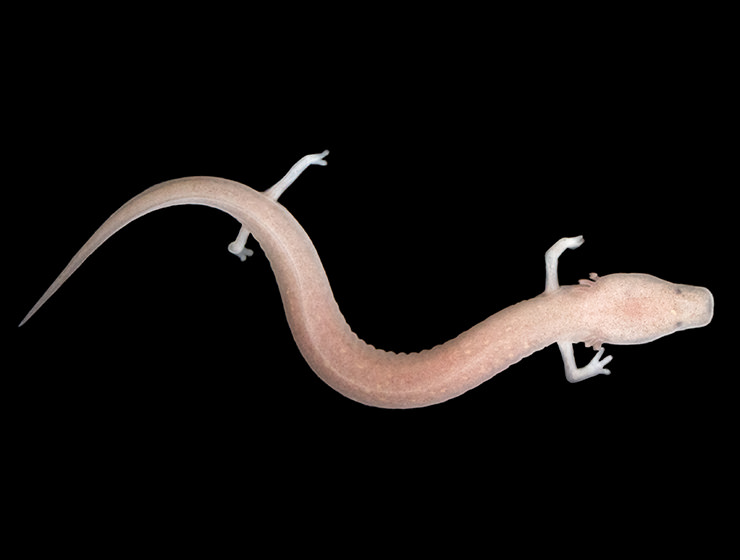
Keep reading this honest Postojna Cave review to find out what makes it one of the best caves in Slovenia, and why it is a brilliant choice for anyone looking for a memorable hiking expedition. Welcome to the largest European show cave!
Why does Slovenia have so many caves?
Slovenia is one of the smaller European countries, with its size being a popular joke material in neighboring Croatia. But under the 20 thousand square kilometers of Slovenian territory, lies a large, less visible world of wonders: more than 13 thousand caves!
With approximately one hundred new caves discovered every year, the experts believe this number is just the tip of the iceberg. They estimate that two-thirds of natural treasures resting under Slovenian feet still wait to be revealed.
These caves are a result of forces of nature shaping the limestone for millions of years. Rains, streams and rivers pouring down and through the mountains affected this soft and porous rock, creating unusual formations above and under the ground.
Caves of Postojna are just a part of these impressive subterranean systems of natural tunnels and chambers, a gigantic secret in the tiny country of Slovenia.
There is a castle near Postojna Cave that has its own caves too. When in Postojna, make sure to visit Predjama Castle nearby too!
Postojna and caves
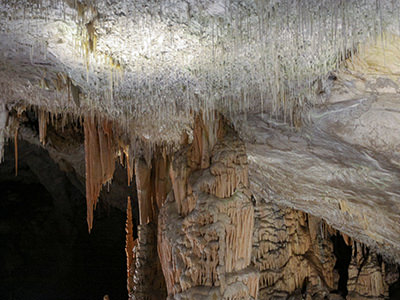
Postojna is a small town with less than 10 thousand inhabitants. But with the most popular European cave attraction, the number of visitors passing through the town was reaching 1 million in pre-pandemic years.
Postojna lies on the Pivka River, the main sculptor that carved out the five caves of the Postojna System: the famous Postojna Cave, the artificially connected Pivka Cave and Black Cave (Črna Jama) movie-location-favorite Otok Cave, and the last discovered Magdalena Cave that is accessible only to experienced explorers.
Where is Postojna Cave located?
If you look at the map of Slovenia, Postojna Cave is located in its bottom-left part, in the Municipality of Postojna.
Postojna Cave location is just 1.5 kilometers away from the center of the town, so you can reach it on foot. It is an easy, 15-minute-long walk.
If you are driving from Koper or Trieste, it will take you 45 minutes. The ride from the capital of Ljubljana is just half an hour long.
How long is Postojna Cave?
Postojna Cave is more than 24 kilometers long! But just over five kilometers of the entire Postojna Cave length are accessible to visitors. More precisely, you will pass 3,7 kilometers by train, and 1,5 kilometers on foot.
But how deep is Postojna Cave, you ask? The deepest point of the cave is 115 meters.
If you were wondering about Postojna Cave’s size in volume, it is estimated the entire system covers 1,7 million cubic meters.
In Greece, one can visit caves where even gods were raised. Zeus Cave is one of the best things to do in Naxos!
Postojna Cave history
How old is Postojna Cave?
Postojna Cave age is estimated at 3 million years. The limestone in which the cave was formed is 70 million years old.
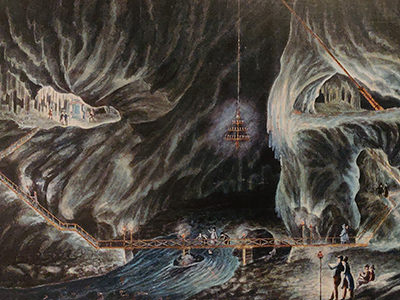
Postojna Cave geology
Postojna Cave formation is directly linked to the impact of the river Pivka. This karst river sinks under the hill of Sovič, and merges with Rak River in Planina Cave, finally reappearing on the surface again as river Unica.
The dissolving action of water has carved the cave as a labyrinth of corridors and chambers filled with a variety of dripstone formations. It is a product of a rather slow process where water passes through limestone and gets oversaturated with dissolved minerals which are then deposited in the cave.
This is the best exhibition of nature’s sculpture I have ever seensculptor Henry Moore
Over a million years, water dripping creates stalactites, stalagmites, columns, flowstone draperies, pearls, and other forms. The dripstone growth of one millimeter could take anywhere between ten and thousands of years.
A great place to learn about Postojna Cave geology in more detail is the EXPO Postojna Cave Karst exhibition, an interactive display of processes that shaped this part of the Slovenian underground. In the rooms adjacent to the world’s largest exhibition on caves and karst, one can even peek into the world of butterflies, as well as the development of Earth and life over 4,5 billion years.
When was Postojna Cave discovered?
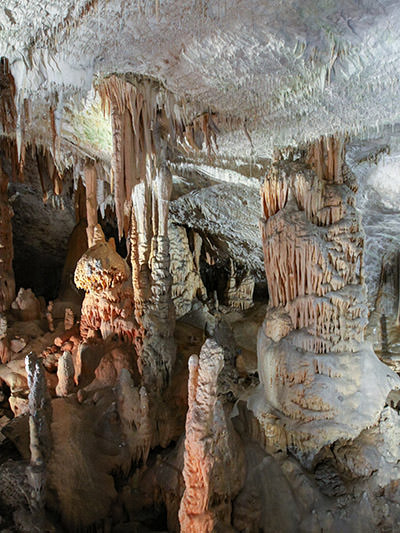
As testified by visitors’ signatures, people have been entering the first passages of the cave since the 13th century. The earliest autograph on the wall of the Old Signatures Passage dates back to 1213.
But the official date of discovery of what we call Postojna Cave today is the 14th of April, 1818. On this day, the local lamplighter Luka Čeč, while preparing the cave for the visit of the Austrian Emperor Franz I, crossed the river, climbed some rocks, and disappeared.
After some time, he returned to his worried colleagues, with eyes wide open. Allegedly, his first words were: “Here is a new world, here is paradise!”
This simple man did not only discover the new and the most beautiful part of the cave.
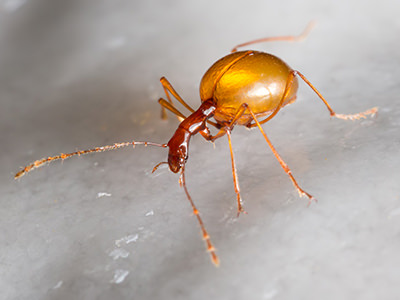
Thirteen years later, he also disproved the scientists’ claims that life without the sun is impossible. In September 1831, on a stalactite below the Great Mountain, Luka Čeč discovered a small brown beetle – today known as the slenderneck beetle.
It was one of many (more than 150, as a matter of fact) animal species that were later confirmed to inhabit Postojna Cave. Slovenian underground became the cradle of a new, literally groundbreaking science of subterranean life – speleobiology.
Postojna Cave train ride – the tourism booster
Two centuries of Postojna Cave tourism were boosted by inventions in transporting visitors to its furthest parts. Exploring the cave on foot, equipped only with torches and candles, was several hours long and back-breaking activity.
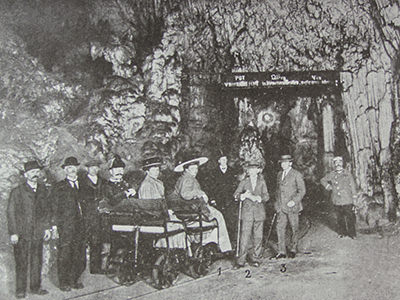
When the emperor Franz Joseph arrived with his wife Elizabeth in 1857, they were taken around in sedan chairs.
But on June 16, 1872, the first cave railway in the world was launched here. Two carriages, each transporting four passengers, were pushed by the cave guides. Luckily for them, Postojna Cave is mostly horizontal.
Postojna, in the Austro-Hungarian Empire known as Adelsberg, would become a part of the Kingdom of Italy after World War I, and change its name to Postumia. In 1923, the Italian authorities renovated and extended the cave railway, introducing the petrol-powered engine. The first one could pull 20 passengers through the cave, but with the influx of visitors, more powerful locomotives were purchased, able to carry 150 visitors.
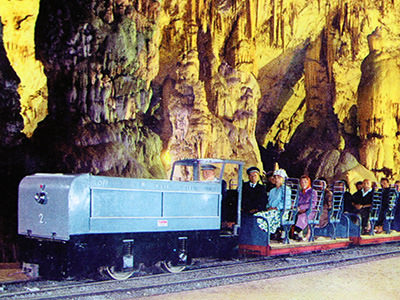
The real tourism boom in Postojna Cave happened after World War II when it became a territory of Yugoslavia. From 1956, battery-powered electric locomotives pulled the carriages. The transfer from a single-track railway to a circular double-track line in the 1960s further increased the daily capacity of the cave.
In the timeframe of 200 years, more than 40 million people visited Postojna Cave. The number includes 15 emperors and empresses, 21 kings and queens, 67 princes and princesses, 54 presidents of states, 37 prime ministers, and hundreds of other eminent guests.
One of the famous visitors was Thomas Cook, the father of organized travel. He discovered the cave in 1868 and then included it in his first trip around the world in 1873.
At Batu Caves in Malaysia, religious fairs boost tourism. The extreme Hindu piercing festival of Thaipusam attracts millions.
Postojna Cave visit
My visit to Postojna Cave surely didn’t have the historical importance of those imperial visits of the 19th century, but I still received the privilege of somewhat royal treatment. I would be exploring the cave with a dedicated cave guide, and I do believe one-on-one encounter of this kind is the best way to experience such a massively popular tourist destination.
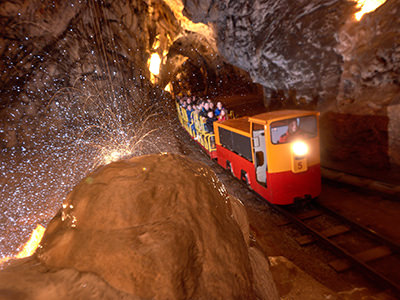
My cave host Stanislav Glažar bombed me with a surprising fact as soon as we met. Pivka, the mighty river that shaped Postojna Cave, sometimes exhibits its power outside too. Heavy rainfalls combined with snowmelt were known to create extreme floods at the cave entrance.
The last one in February 2019, peaked at 7 meters above the usual levels, essentially drowning the road and Postojna Cave parking lots. As markings on one building show, extreme floods have become more common in the last decades, happening even in autumn, such as the one in November 1987, or September 2010.
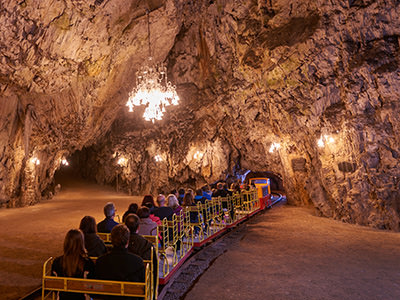
Deeper in the cave, I will open a discussion about another natural hazard – earthquakes. While they do happen, the tremor mostly blends into the underground noises visitors are not accustomed to, Stanislav claims. Evacuations are extremely rare.
If you would be shaken by anything, it would probably be the temperature difference between the outside and the cave interior.
If walking from Postojna town to the cave like me, reserve enough time to get to your tour without rushing! While I did arrive in time, the effect of some sweat under my shirt got extremely multiplied once inside.
Postojna Cave temperature is 10 degrees Celsius, and while I found it bearable when walking, the train ride had all the elements of the “Snowpiercer”. My light summer hoodie was jealous of Stanislav’s winter jacket.
Monument to electricity
Hopping on an electric train in Postojna Cave is not the only benefit of our experience when we compare it with one of the early visitors two centuries ago. The difference between seeing the cave illuminated by torches, candles, and burning bundles of straw, and seeing it with modern electric lights is like comparing the view of the night sky with the naked eye and seeing the universe with the James Webb telescope.
The arc lamps in the cave were introduced on July 15, 1883, much before even some major European capitals saw their first electric bulbs (Ljubljana included!). Visitors were exiting the cave in tears as if they were enlightened.
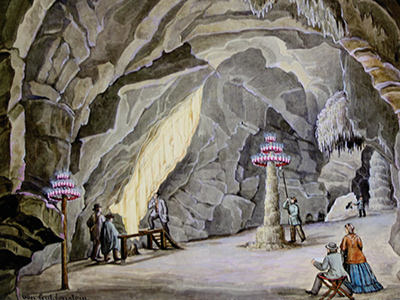
The first part of the cave that was illuminated was the Ballroom, a dance hall the train would quickly pass through, but it would not leave you unimpressed. After the First World War, a giant Murano glass chandelier was installed here, and it added to the surreal experience of Postojna Cave’s unique 10-minute train ride.
Another remarkable cave formation that would go unnoticed without proper lighting is a dripstone resembling a hanging curtain. Having a tour guide pointing out where to look during the Postojna Cave train ride was another advantage larger tour groups just do not get the privilege to experience.
If you want to enjoy the full splendor or modern technologies, consider visiting Postojna Cave between Christmas and New Year. In the period of festivities, the biblical story of the birth of Jesus is brought to life in the Living Nativity scene, and the cave interior gets an additional touch of light magic.
From Calvary to Brilliant via Spaghetti Hall
The place where we alighted the train also had a Biblical name – the Calvary. Also known as the Great Mountain, this enormous space was a striking sight. After what could have been experienced as mainly a fun train ride, it was here that I fully became aware of the gigantic proportions of Postojna Cave. Hundreds of stalagmites rose up as a forest of natural skyscrapers, headlined by a 16-meter-tall giant, the result of 150 thousand years of water dripping.
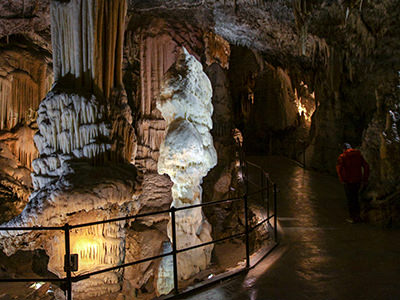
Again, my tour guide opened up the barrier to special pathways, allowing me to experience the view from the top of the cave, where larger groups were not allowed. By the time we finished, the rest of the train crowd was rushed up further into the cave, hidden by lights turning off and silenced by the cave walls. It almost felt like I had a privileged private visit, sometimes literally, when my guide would leave me for some moments, while he would wander off-path, to check some scientific instruments.
Continuing to deeper parts of the complex, the so-called Beautiful Caves, we crossed a large chasm. The man-made construction is called the Russian Bridge, after Russian prisoners of war who were brought to the cave in 1916 and forced to build it. It still holds well.
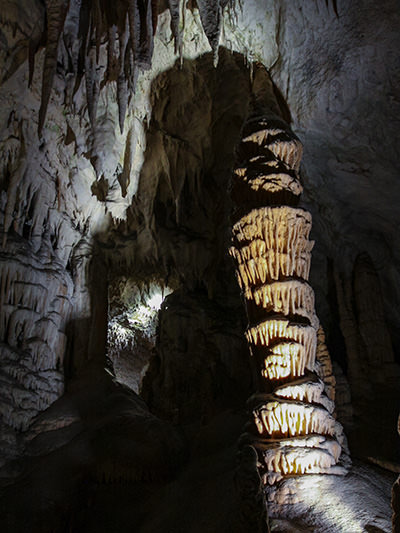
Here, the formation known as the Leaning Tower of Pisa caught my eye. But among the caves that got names after the color of rocks, depending on the amount of calcite or iron (White and Red Halls), my favorite was the one that was named after the shape of the stalactites. The Spaghetti Hall literally looks as if someone has thrown thousands of thin noodles in the air, and they got stuck on the ceiling. These hanging strings supposedly grow a centimeter every 400 years!
The star of Postojna Cave postcards is however the Brilliant, a five-meter tall stalagmite made of pure calcite, which gives it a strikingly bright shine, especially when contrasted to the neighboring ornament-rich pillar.
Proteus Anguinus – Postojna Cave dragon
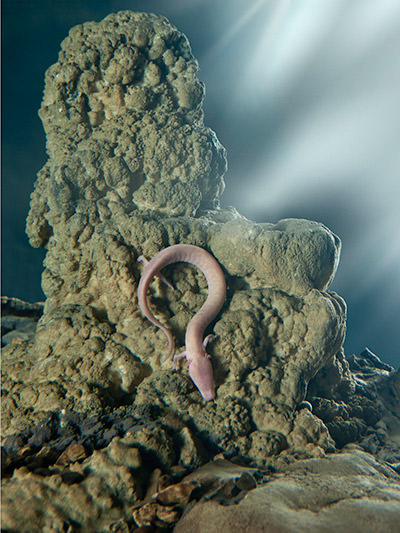
The most fascinating sight in Postojna Cave is however not offered by a rock, but by an animal – the elusive amphibian, the world’s only vertebrate living exclusively underground.
The olm, scientifically known as proteus anguinus, is completely adapted to living in the darkness. It is a pale eyeless being, 30 centimeters in length. While having a snakelike body, it has four short legs counting ten digits in total. It can breathe both by gills and by rudimentary lungs.
Endemic for Dinaric karst, olms learned to survive with a very specific metabolism. Their heart beats twice a minute, they can go without food for longer than a decade, and even then, they can still reach an old age of 100 years. If it loses a limb, proteus can regrow it!
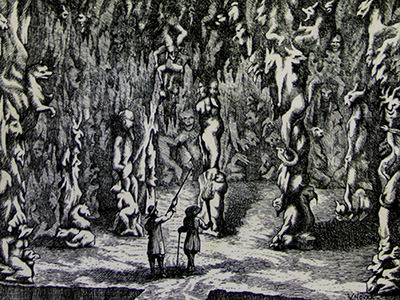
Postojna cave’s most unusual tenant was first spotted in the 17th century when bursting underground rivers would bring these extraordinary animals to the surface. As if floods were not terrifying enough, locals that saw the olms, believed they were actually the babies of an evil dragon. In winter, the mist would spew from the cave. So if it ain’t the chimney of elves’ workshop, it could only be a breath of the mommy dragon.
In the culminating part of our Postojna Cave tour, the blind cave salamanders were resting in an aquarium, the only part of the cave where the lighting was intentionally omitted. It was clear why, for the simple people of yesteryears, olms could have fed fears of a fantastic creature living in the dark depths of the mountain.
Greece also has its legends of dragons in the mountains. They believe a dragon fight created some of the prettiest parts of the Zagori landscape.
The house of dragons – between hope and disaster
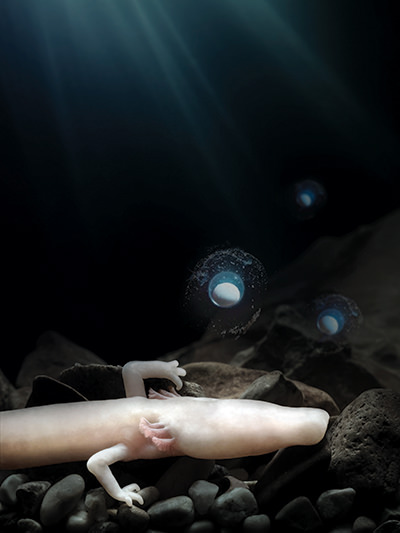
Locally called human fish, Postojna Cave baby dragons were classified under their Latin name proteus anguinus in 1768.
The world’s largest underground creature ended up even in Charles Darwin‘s influential work “On the Origin of Species“ (1859), where he referred to olms as surprisingly rare “wrecks of ancient life”.
Some scholars of the time theorized that olms didn’t even reproduce, but were instead – immortal.
The scientific fascination with the creatures continued until today. The 21st century enabled scientists the first glimpse into the reproduction of proteus.
In 2016, we could finally observe the breeding of this unique species. One olm has laid eggs in the aquarium, and 22 babies have hatched.
In 2022, the most biologically diverse cave in the world had a new baby boom, this time with 32 little dragons!
Besides Postojna Cave itself, one can see olms in the Vivarium, the home to a research laboratory, as well as a speleobiological exhibition in the Passage of New Signatures.
While Vivarium does shed light on the life of Postojna Cave animals in an interactive way for audiences, I found this area of the complex overcrowded and understaffed. That combo could only result in uneducated members of the public using their flashlights in search of these vulnerable creatures, just for a lousy photo. I believe visitor management in Postojna’s Vivarium could seriously be improved.
Scientists are using groundbreaking technologies to try to raise babies of even functionally extinct species. Check out the fantastic photographs of the last northern white rhinos, made by Slovenian photographer Matjaž Krivic!
The world’s only underground post office
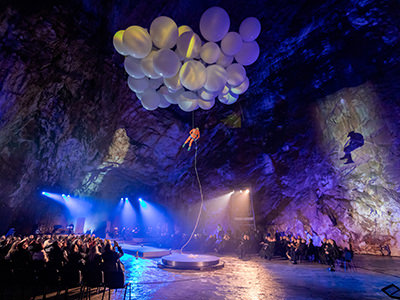
My tour of Postojna Cave finished in the gigantic Concert Hall. With 3 thousand cubic meters, the largest cavern of the Postojna Cave system has become famous for its excellent acoustics. It successfully hosted performances from soloists via octets to entire symphony orchestras. The audience capacity is impressive as well: it can welcome 10 thousand people!
Before hopping back on a train that brings you out of Postojna Cave, there is a gift shop where you can supply yourself with a range of souvenirs, from magnets and mugs to olm-shaped toys.
But maybe the best present you can take from the cave is one that revokes nostalgia for the times gone by, when writing letters by hand was still a thing.
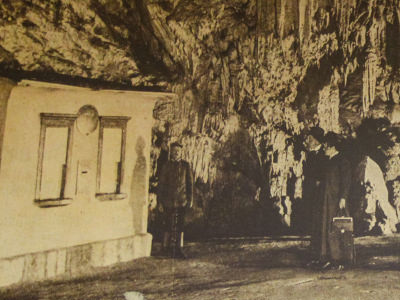
You can actually purchase unique postcards and proteus postmarks, and send them via the only underground post office in the world.
The original post building opened back in 1899, near the Dance Hall, during Austrian rule. But in 1927, the Italians built a new one in the Concert Hall.
On Postojna Cave’s busiest days, post officials had to stamp an almost unbelievable number of 90 thousand postcards.
Conclusion – Is Postojna Cave worth visiting?
First known as Grotte de Adelsberg, then Grotte di Postumia, and today as Postojnska jama, Postojna Cave was silently waiting while political powers fought over the territory of today’s Slovenia.
As it usually happens, nature outgrows the actions of humans, and Postojna Cave is a monument to forces older and stronger than our civilization.
That is not to say that environment will always outlive the people. Proteus or olms are an example of a vulnerable species depending on how we treat nature around us.
Postojna Cave Park is an inspiring place where one can take a glimpse into previously unseen worlds, and hopefully, even learn about ourselves
There have been instances when human fish was given to dignitaries as presents, but these champions of survival would die as soon as the temperature would rise above the one in their natural habitat.
Animals that could hold secrets to longevity and recuperation are masters of adaptation, but they have been evolving through centuries. And humans prefer radical and instant gratification.
While they can fast for a decade, olms can live only in the purest waters. Their underground habitat is constantly under the pressure of how we treat nature above the ground.
Postojna Cave Park is definitely an inspiring place where one can take a glimpse into previously unseen worlds, and hopefully even learn about ourselves.
For millions of years, water has been sculpting the world beyond human view. It could have been on another planet, but it was right under the same soil we walked on.
When left alone, nature can become a creator of exceptional beauty and a mother of life in the least favorable circumstances.
Hopping on the world’s first underground train, in operation for a century and a half, and exploring the ever-surprising karst underworld is an adventure expedition worthy of Jules Verne’s novels.
Visiting Postojna Cave is one of the best things to do in Postojna, and a reason enough to book a trip to the secret worlds of underground Slovenia.
Postojna Cave quick facts
Postojna Cave address
The exact address of the cave is Jamska cesta 28, 6230 Postojna, Slovenia.
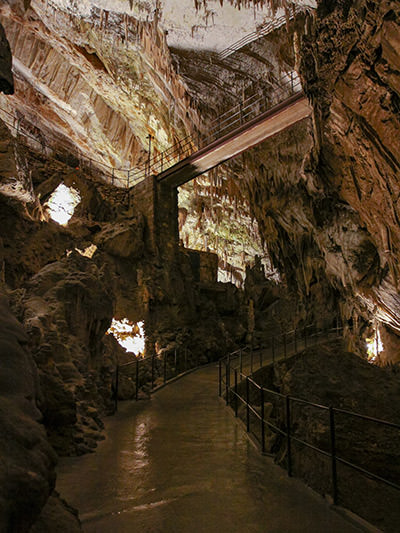
Postojna Cave pronunciation
The correct way of pronouncing Postojna is [post-oy-nah]. You can hear a native Slovenian speaker pronouncing it here.
Postojna Cave’s opening hours
From November to March, Postojna Cave tour times are at 10:00, 12:00, and 15:00.
With the arrival of spring, tours become more frequent, culminating in summer months when Postojna Cave’s working hours start at 9:00 and end at 18:00.
How long is the Postojna Cave tour?
Postojna Cave tour duration is typically 1,5 hours. But if you want to include the Vivarium and EXPO Postojna Cave Karst exhibitions in your visit, double that time.
Postojna Cave tickets
An adult ticket for Postojna Cave costs 27,90 Euros. Persons from 16 to 25 years of age pay a discounted entrance fee of 22,30 Euros. The entry fee for children from 6 to 15 years of age is 16,70 Euros. Postojna Cave’s price for children up to 5 years is 1 Euro. Speaking of children, visiting Postojna Cave with a baby is possible; footpaths are adapted to prams of a maximum of 80 cm width. Just make sure that it is foldable, so you can load it on the train.
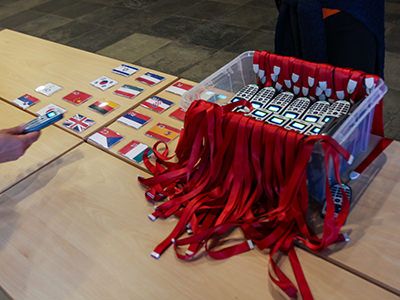
Combining several attractions of Postojna Cave Park will entitle you to additional savings on the ticket price.
For instance, if you are an adult, and besides Postojna Cave, you also want to visit Vivarium, EXPO Cave Karst, “Life within a Billion Years” and “Butterflies of the World” exhibitions, the package will cost you 39,20 Euros.
If you want to combine the Postojna Cave visit with Predjama Castle (strongly recommended!), these two attractions will cost you 40,30 Euros.
The price of the full park experience would be 46,60 Euros.
There are additional adventures you can undertake in the park, from cave trekking to VIP tours. For exact ticket prices, consult the official park page.
Are dogs allowed in Postojna Cave?
While you can arrive at Postojna Cave with a dog, your pet will not be allowed to accompany you inside the park attractions. You will have to leave it in one of the provided kennels. This service is free for ticket holders.
Postojna Cave weather
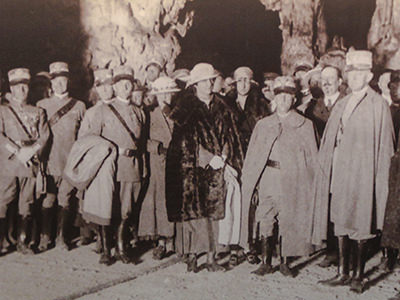
Postojna Cave is open year-round, regardless of the weather forecast (well, excluding the rare events of extreme rains resulting in flooding).
The temperature inside Postojna Cave is quite stable throughout the year, between 8 and 10 degrees Celsius.
Make sure to wear suitable clothing and comfortable shoes. If you need to rent a pelerine coat at the entrance of the cave, it will cost you 5 Euros.
Getting to Postojna Cave
The town of Postojna is accessible by car, bus, or railway. The nearest airports are in Ljubljana, Trieste, and Rijeka. You could also consider flying to Venice, Milan, Pula, or Zagreb.
There are hourly buses from Ljubljana to Postojna. You can also join this excellently rated Postojna Cave tour from Ljubljana, with a professional English-speaking guide.
If you are traveling from Bled to Postojna Cave, you can join this small-group tour.
Postojna Cave is a 45-minute ride away from the town of Koper. If coming from this coastal Slovenian town, join this day trip. Travelers from Piran should join this tour.
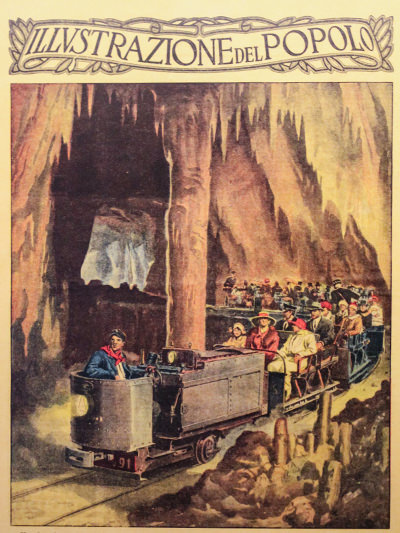
Arriving from Italy is not complicated either. From Trieste, it will take you less than 1 hour over the A1 motorway. For peace of mind, join this Postojna Cave tour from Trieste, with the lowest price guarantee.
If you are heading to Postojna Cave from Venice, the ride would be around 2 hours. Keep in mind that Postojna is a stop on the Venice-Vienna railway line.
Postojna Cave visit is popular among tourists spending their holidays in Croatia too. From Rijeka, you will get to Postojna Cave in under an hour. A trip from Zagreb to Postojna Cave will take 2 hours of your time. From further locations, such as Zadar, reserve at least 4 hours for the ride.
Visitors from Zagreb should consider this grand Slovenian tour that includes Postojna Cave, but also Ljubljana, and Lake Bled. Day trips are also available from towns such as Rovinj, Pula, and Rijeka.
Where to stay when visiting Postojna Cave?
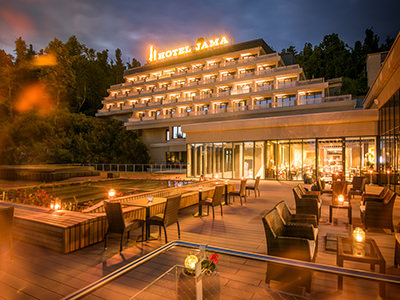
The most convenient place to stay when visiting Postojna Cave is Hotel Jama, practically at the doorstep of the cave. Completely renovated in 2016, this 4-star hotel has superb reviews on booking sites. A double room is available for 136 Euros, but for the exact prices of your dates, visit this link. Read my detailed review of Hotel Jama here!
Another 4-star option is Hotel Kras, the elegant accommodation in the center of Postojna, with magnificent views of the Nanos Plateau. You can get a double room in this hotel for 90 Euros. Check out their availability and prices here.
If you are looking for eco-friendly options, your best pick is ECO Hotel Center. You can find a double room at this 3-star accommodation already for 64 Euros. Check out their availability and prices for your dates here.
For those of you who prefer staying closer to nature, an option worth considering is Camping Pivka Jama. From mid-April to mid-October, you can rent a two-bedroom bungalow here, starting from 53 Euros. For actual prices and availability for your dates, click here.
One of the most economical options for staying in Postojna is Youth Hotel Proteus. Bed in a dormitory starts from 20 Euros, while a single room can be purchased for 29. For updated prices and availability for your dates, click here.
For other accommodation options in the vicinity of Postojna Cave, click here.
Did you like this Postojna Cave review?
Pin it for later!
Disclosure: My Postojna Cave visit was complimentary, but all opinions are my own. Also, this post might contain affiliate links, which means if you click on them and make a purchase, Pipeaway might make a small commission, at no additional cost to you. Thank you for supporting our work!

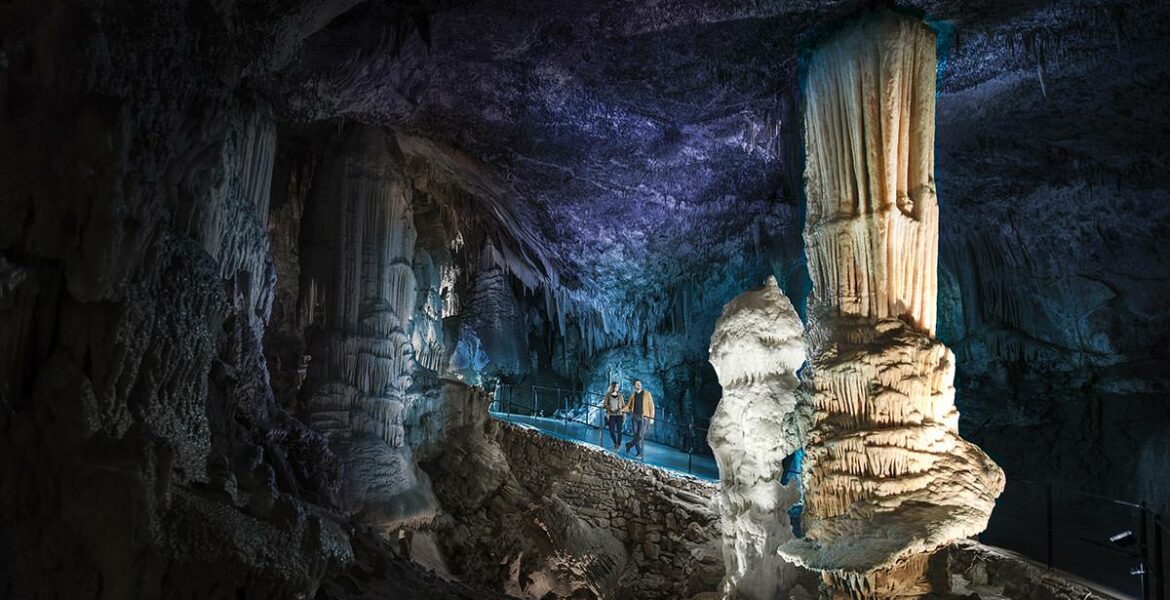
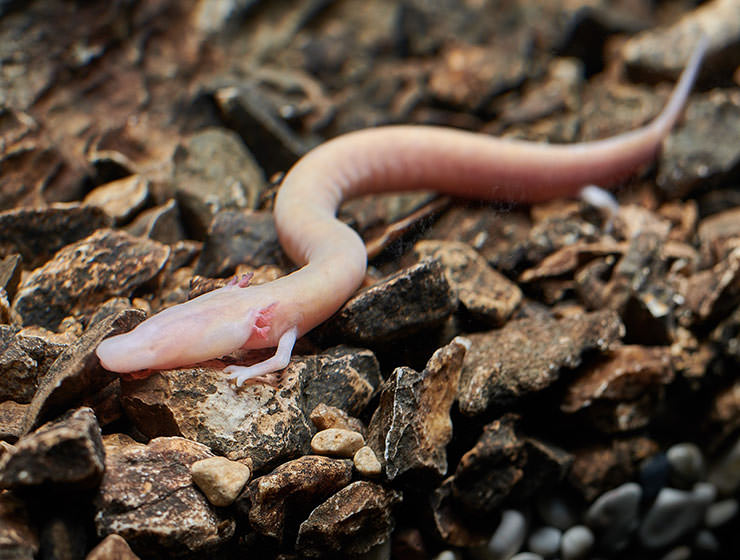
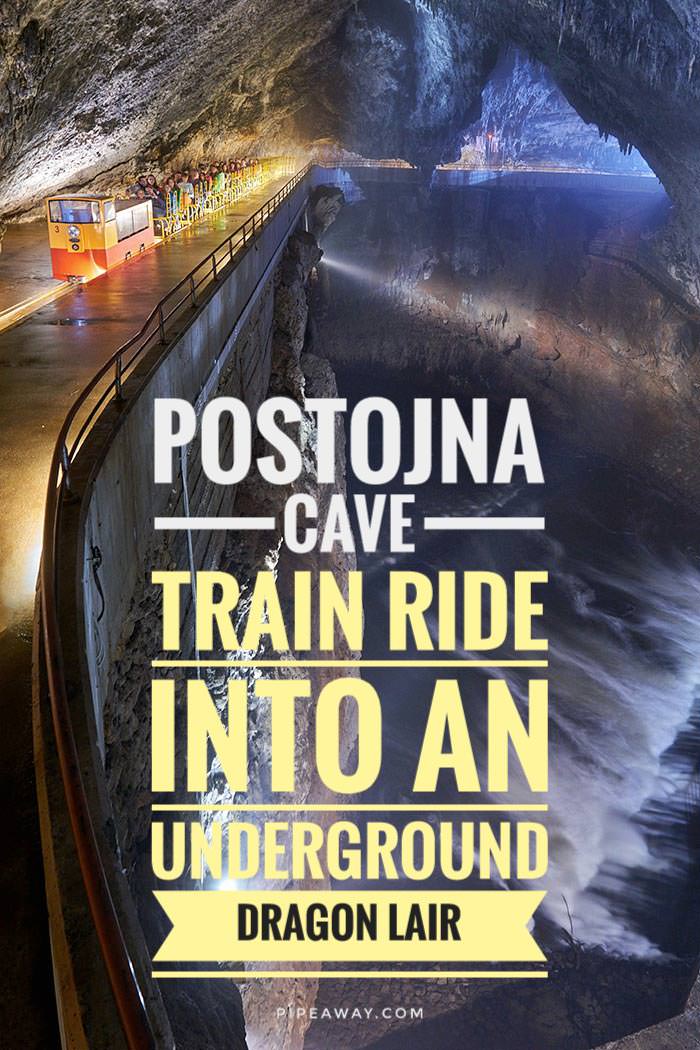
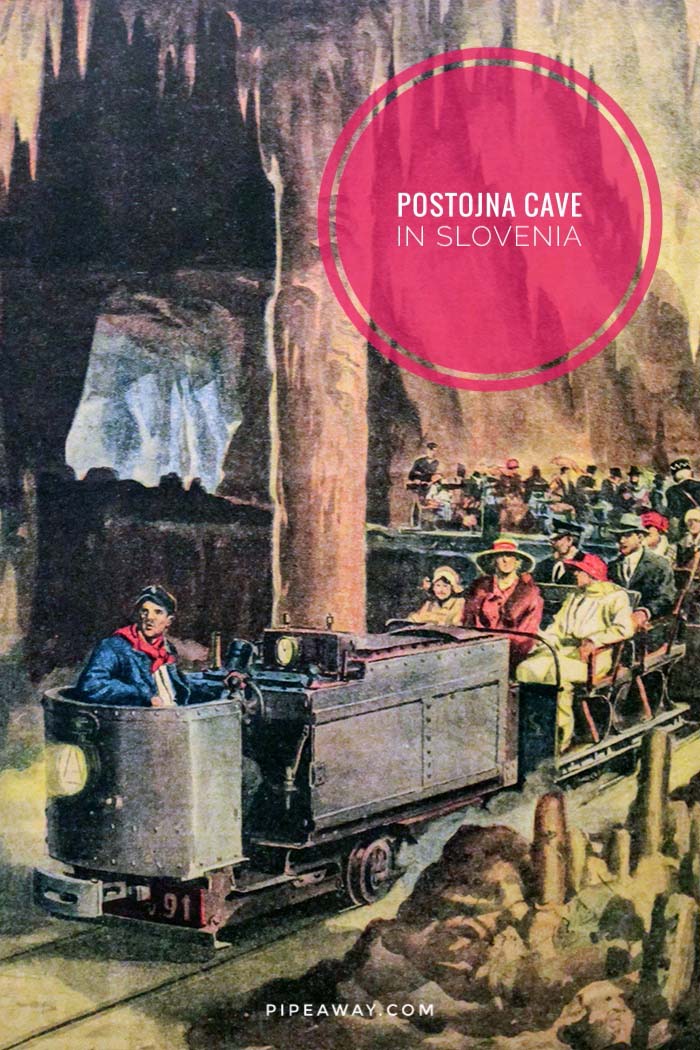

Dear Madam, dear sir,
I am afraid of heights, not a little bit but really petrified. Can I do the tour by train and also come back out of the cave by train? I cannot do the walk, that is sure.. So up and down by train or I cannot visit the cave.
I read 3.7 km by train (and then also 3.7 km back for me) and thus not the 1.5 on foot.
How far is this cave park from Ljubljana?
At what time are the train rides in the cark? (we want to hire a car and stop at the cave for a train ride in the cave) and go on to Piran for the afternoon and then in the evening back to Ljubljana.
Kind regards,
els
Dear Els,
Thank you for your comment and for considering a visit to Postojna Cave. I completely understand your fear of heights and I’m happy to inform you that you can definitely take the train tour through the cave.
The train takes you deep into the cave, where you can see the amazing rock formations and learn about the cave’s history and geology. The train ride covers a distance of about 3.7 km. You can also take the train back to the entrance of the cave.
Have in mind that it’s not the slowest train, its prime role is transport, and secondary – sightseeing. While you do get to see some stunning parts of the cave, you’ll pass rather quickly through them.
You didn’t mention what type of difficulties with walking you have. Postojna Cave is actually adapted to disabled visitors, so you could see many of its parts even in a wheelchair.
The best would really be to contact the cave office, and see if they can design your visit according to what works for you.
Regarding your question about the distance from Ljubljana to Postojna Cave, it’s about 50 km or a 45-minute drive.
As for the train rides in the park, these days, they operate daily from 9:00 am to 5:00 pm, and depart every half hour or so. It’s important to note that during the high season (June-August), there might be longer waiting times.
Your drive to Piran should take additional 70 minutes.
I hope this information helps you plan your trip. Don’t hesitate to reach out if you have any further questions.
Best regards,
Ivan